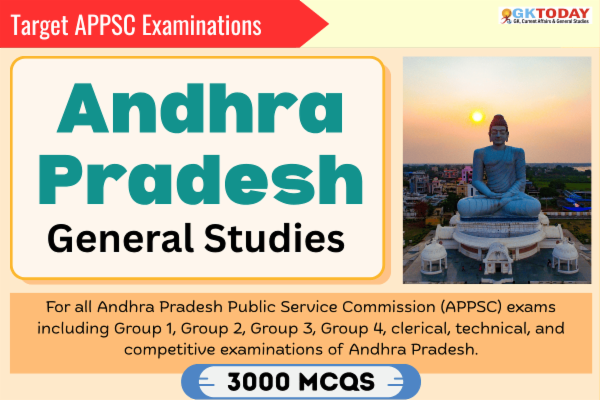States PCS: Andhra Pradesh GK For APPSC Examinations
For all Andhra Pradesh Public Service Commission (APPSC) exams including Group 1, Group 2, Group 3, Group 4, clerical, technical, and competitive examinations of Andhra Pradesh.
41. Which text compiled by Vatsyayana lists the 64 traditional arts (kalās) essential for refined living, many of which were promoted by dynasties like the Satavahanas and Vijayanagara in Andhra Pradesh?
[A] Kamasutra
[B] Natya Shastra
[C] Arthashastra
[D] Silappadikaram
Show Answer
Correct Answer: A [Kamasutra]
Notes:
Kamasutra by Vatsyayana enumerates 64 kalās; these arts flourished under Andhra dynasties, influencing music, dance, sculpture, and manuscripts.
42. Which famous Telugu lyricist and composer was a contemporary of Saluva Narasimha Raya, the ruler of the Vijayanagara Empire?
[A] Tyagaraja
[B] Kshetrayya
[C] Annamacharya (Annamayya)
[D] Ramadasu
Show Answer
Correct Answer: C [Annamacharya (Annamayya)]
Notes:
Annamacharya (Annamayya), born in 1408 in Tallapaka, Andhra Pradesh, composed over 32,000 devotional songs and lived during Saluva Narasimha Raya’s rule (1485–1491).
43. Which of the following titles were commonly used by feudatories during the Satavahana period in Andhra Pradesh?
[A] Maharana and Samanta
[B] Raja and Nayaka
[C] Maharathi and Mahabhoja
[D] Senapati and Mandalika
Show Answer
Correct Answer: C [Maharathi and Mahabhoja]
Notes:
Maharathi and Mahabhoja were prominent feudatory titles under the Satavahanas, reflecting military and land rights authority in the Deccan.
44. Which of the following historical figures from Andhra Pradesh is NOT known as a verified devotee of Lord Shiva, according to authentic epigraphic or inscriptional records?
[A] Prola II
[B] Jayavarma
[C] Kakatiya Rudradeva
[D] Erra Pratapa Reddy
Show Answer
Correct Answer: B [Jayavarma]
Notes:
Jayavarma is not cited as a Shiva devotee in any verified Andhra Pradesh historical, epigraphic, or inscriptional records.
45. What was the emblem adopted by the Salankayana dynasty of coastal Andhra Pradesh?
[A] Elephant
[B] Lotus
[C] Bull
[D] Conch
Show Answer
Correct Answer: C [Bull]
Notes:
The Salankayanas used the bull as their emblem, as evidenced by Brahmi inscriptions and coins from their rule in coastal Andhra Pradesh (3rd–6th centuries CE).
46. Who was honored by Ganapathi Deva with the titles “Eepwilutaka” and “Deeni Churakara” for achieving victory in Deeni Dweepa?
[A] Malayala Bhounda Senali
[B] Prola II
[C] Rudrama Devi
[D] Manuma Siddhi
Show Answer
Correct Answer: A [Malayala Bhounda Senali]
Notes:
Ganapati Deva awarded Malayala Bhounda Senali the titles “Eepwilutaka” and “Deeni Churakara” in recognition of his victory in Deeni Dweepa in 1234 CE, marking strategic expansion in Kakatiya rule.
47. During the reign of which ruler of Andhra Pradesh did Buddhism flourish, marked by significant patronage of monastic complexes and Buddhist art at Nagarjunakonda?
[A] Virapurushadatta
[B] Gautamiputra Satakarni
[C] Rudradaman I
[D] Pulakeshin II
Show Answer
Correct Answer: A [Virapurushadatta]
Notes:
Buddhism flourished under King Virapurushadatta of the Ikshvaku dynasty (3rd century CE), who patronized Buddha viharas, stupas, and learning centers at Nagarjunakonda in Andhra Pradesh.
48. Who authored the Telugu commentary “Kumara Giri Rajeeyam” on Kalidasa’s play Abhijnanasakuntalam?
[A] Kumara Giri Reddy
[B] Kataya Verna Reddy
[C] Vemana
[D] Rayaprolu Subbarao
Show Answer
Correct Answer: B [Kataya Verna Reddy]
Notes:
Kataya Verna Reddy, an 18th-century Tirupati scholar and brother-in-law of Kumara Giri Reddy, wrote “Kumara Giri Rajeeyam,” a Telugu commentary on Abhijnanasakuntalam; manuscripts exist in Andhra Pradesh State Archives and Madras Library.
49. In which city was Andhra University originally established in 1926?
[A] Waltair (now part of Visakhapatnam)
[B] Vijayawada
[C] Guntur
[D] Kakinada
Show Answer
Correct Answer: A [Waltair (now part of Visakhapatnam)]
Notes:
Andhra University was first established in Waltair, now part of Visakhapatnam, in 1926 under the Madras Presidency.
50. Who was Bahubala Santamula-I, known for ruling parts of southeast Andhra Pradesh in the 5th century CE?
[A] King of the Western Chalukyas
[B] Son of Virapurusha Datta and ruler of the Santamula dynasty in coastal Andhra Pradesh
[C] Founder of the Kakatiya dynasty
[D] Famous Mauryan governor of Srikakulam
Show Answer
Correct Answer: B [Son of Virapurusha Datta and ruler of the Santamula dynasty in coastal Andhra Pradesh]
Notes:
Bahubala Santamula-I, son of Virapurusha Datta, ruled southeast Andhra Pradesh as a Santamula dynasty king, focusing on the Kalinga and Vishakhapatnam areas; he is noted for irrigation, fortifying trade, temple building, and administrative reforms.

